An organization’s most important asset is its employees. Healthcare workers, in particular, carry the responsibility of enacting their employers’ caregiving missions. To protect their most important asset, organizations must enact practices that keep employees safe. Controlling workplace hazards is critical to maintaining a productive, satisfied workforce. A culture of safety furthermore reduces costs: by reducing employee injuries, employers avoid expensive insurance and workers’ compensation claims. A workplace violence safety plan plays a critical role in loss prevention and risk management strategies. By creating a culture of safety, healthcare employers can invest their financial and organizational resources into what really matters—people.
Loss Prevention in the Healthcare Workplace
Loss prevention refers to measures taken to prevent the loss of life, health, and property. In the workplace, this involves preventing accidents, reducing risks, and controlling known hazards. The goal of loss prevention is to bring the organization’s accidents as close to zero as possible. By implementing an effective loss prevention strategy, organizations cultivate better employee habits, a strong safety culture, and improved attitudes toward safety.
In healthcare settings, preventing employee injuries is paramount; injured workers cannot care effectively for patients. Working to prevent incidents of workplace violence is also an important element of loss prevention. Providers who have experienced violence in the workplace are susceptible to PTSD, burnout, absenteeism, and career changes. By implementing a workplace violence safety plan, healthcare organizations can prevent the losses that result from these phenomena.
Benefits of Loss Prevention Strategies
According to American Family Insurance, at its core, loss control (or “loss prevention”) is about the employer caring for employees and their safety. A loss control program seeks to reduce potential losses, mitigate damage during an incident, manage claims effectively, recover from losses, review incidents, and implement ways to prevent reoccurrence. Employers wishing to implement a workplace violence safety plan must analyze potential hazards and risks in the workplace, including aggressive patients and other sources of conflict. Then employers must put controls, practices, and policies in place to prevent or mitigate violence. These must be followed up with employee training on best safety practices.
This type of strategic approach to loss prevention:
- creates a safer work environment
- reduces illnesses, injuries, and fatalities
- decreases workers’ compensation claims
- improves relations between employees and management
- lowers turnover rate
- increases productivity
A workplace violence safety plan that is part of a comprehensive loss prevention strategy not only makes workers safer but also improves employee efficiency and prevents costs associated with workers’ compensation claims and employee injury.
Risk Management Improves Safety and Keeps Costs Down

Workplace violence safety plan
Every year, approximately two million people lose their lives due to occupational accidents and work-related diseases worldwide. Roughly 270 million work accidents occur globally every year, endangering employee well-being and disrupting operations. These accidents prompt increases in insurance and workers’ compensation costs and legal fees. Employers have ample reason to engage in risk management strategies that keep workers safe and costs down.
Risk management is the set of practices by which administrators enact loss prevention. Risk management in healthcare comprises the clinical and administrative systems, processes, and reports employed to detect, monitor, assess, mitigate, and prevent risks. Effective risk management practices safeguard patient and employee safety. They safeguard organization assets, market share, accreditation, reimbursement levels, brand value, and community standing. The positive impacts of effective risk management extend to all aspects of a healthcare organization.
Safety professionals divide occupational risks into six different categories:
- safety hazards: spills, falls, trips, moving or unguarded machinery, confined spaces, electrical hazards
- biological hazards: viruses, bacteria, and fungi that can cause infectious diseases, toxic plants, molds
- ergonomic hazards: awkward sitting postures, repetitive motions, pushing, bending, pulling, heavy lifting
- physical hazards: high heat, loud noise, sources of radiation
- chemical hazards: toxic chemicals
- psychosocial hazards: overwork, workplace violence, harassment
Healthcare workers are susceptible to many of these categories of risk. Psychosocial hazards—particularly workplace violence—are on the rise in healthcare settings. It is the employer’s responsibility to initiate a workplace violence safety plan to mitigate these risks.
Safety Plans Achieve Regulatory Compliance
U.S. Department of Labor agencies administer and enforce laws enacted to protect the safety and health of workers in America. OSHA administers the Occupational Safety and Health Act. Under this law, most private industries’ safety and health conditions are regulated. Employers are also subject to OSHA regulations; they have a general duty to provide a workplace free from recognized, serious hazards. Under OSHA, federal and state safety personnel support worker safety and health through worksite enforcement, education and compliance assistance, and cooperative and voluntary programs. Noncompliance with OSHA rules can result in hefty fines and further investigation by OSHA officials, neither of which are amenable to productivity or profitability.
Healthcare work environments are also governed by state regulations. For example, New York Industrial Code Rule 59 requires a comprehensive safety and loss prevention consultation and evaluation for employers with an annual payroll of over $800,000 and a workers’ compensation experience modification rating of more than 1.20. The New York Compensation Insurance Rating Board (NYCIRB) issues notices to employers that must participate in the program, and the Department of Labor is responsible for monitoring and compliance. Employers that fail to follow the law receive a five percent surcharge on the manual portion of their workers’ compensation premium. The surcharge goes up an extra five percent for each year they do not comply. Workplaces that do not practice effective risk management must be monitored, and those that don’t achieve compliance take a financial hit. Employers can avoid being regulated in this way by instituting a proactive workplace safety plan that mitigates risk from the outset.
Wearable Emergency Buttons Reduce Risk

Workplace violence safety plan
Employers seeking effective loss prevention strategies are increasingly turning to “wearables.” These include watches, badges, wearable sensors, and even helmets. Recently, wearable technology has expanded beyond personal use and has begun entering the workplace as a way to monitor employee health and safety. In 2019, the market for industrial wearables was $3.8 billion and is expected to reach $8.4 billion by 2027.
Wearable devices can play an important role in an organization’s risk management program: they give employers real-time feedback that helps them create and refine workplace safety practices and protocols. Using wearable technology for this purpose makes workplaces safer. Producers of wearable devices have shared actuarially supported statistics demonstrating that their devices help improve workers’ compensation experience modification ratings. Real-time data about workers’ habits and safety reduces worker’s compensation claims, which in turn reduces costs.
CENTEGIX CrisisAlert is a Risk Management Tool
The CENTEGIX CrisisAlert badge is a wearable emergency button that produces the data employers need to create effective loss prevention programs. Healthcare workers wear the CrisisAlert panic button along with their ID so that it is always accessible. They can use it to call for help from anywhere in a clinic or on a hospital campus and receive immediate help from designated first responders. This creates a climate of safety in which employee well-being is prioritized and the workforce is highly effective.
The CrisisAlert wearable emergency button is a proactive strategy for loss prevention. The CrisisAlert system collects data about employee alerts and makes it accessible to employers on a dashboard. Decision-makers can then utilize this data to make proactive decisions about how to best protect employees from workplace violence. When employers understand where, how often, what times of day, and under what circumstances violent incidents occur, they can target resources more precisely. And CrisisAlert has a 100 percent adoption rate; employees wear the device, so it is accessible in every circumstance.
CrisisAlert is easy to integrate into existing technologies and safety plans. Because it operates on its own network, healthcare organizations do not need to retrofit infrastructure or disrupt their own IT networks. CrisisAlert ensures a remarkable return on investment. Its accurate data can inform risk management practices that help create safe, productive workplaces.
CENTEGIX is the leader in incident response solutions. Our CrisisAlert platform is the fastest and easiest way for staff to call for help in any emergency, from the everyday to the extreme. CENTEGIX creates safer spaces by innovating technology to empower and protect people, and leaders nationwide trust our safety solutions to provide peace of mind. To learn more about CENTEGIX, visit www.centegix.com.










